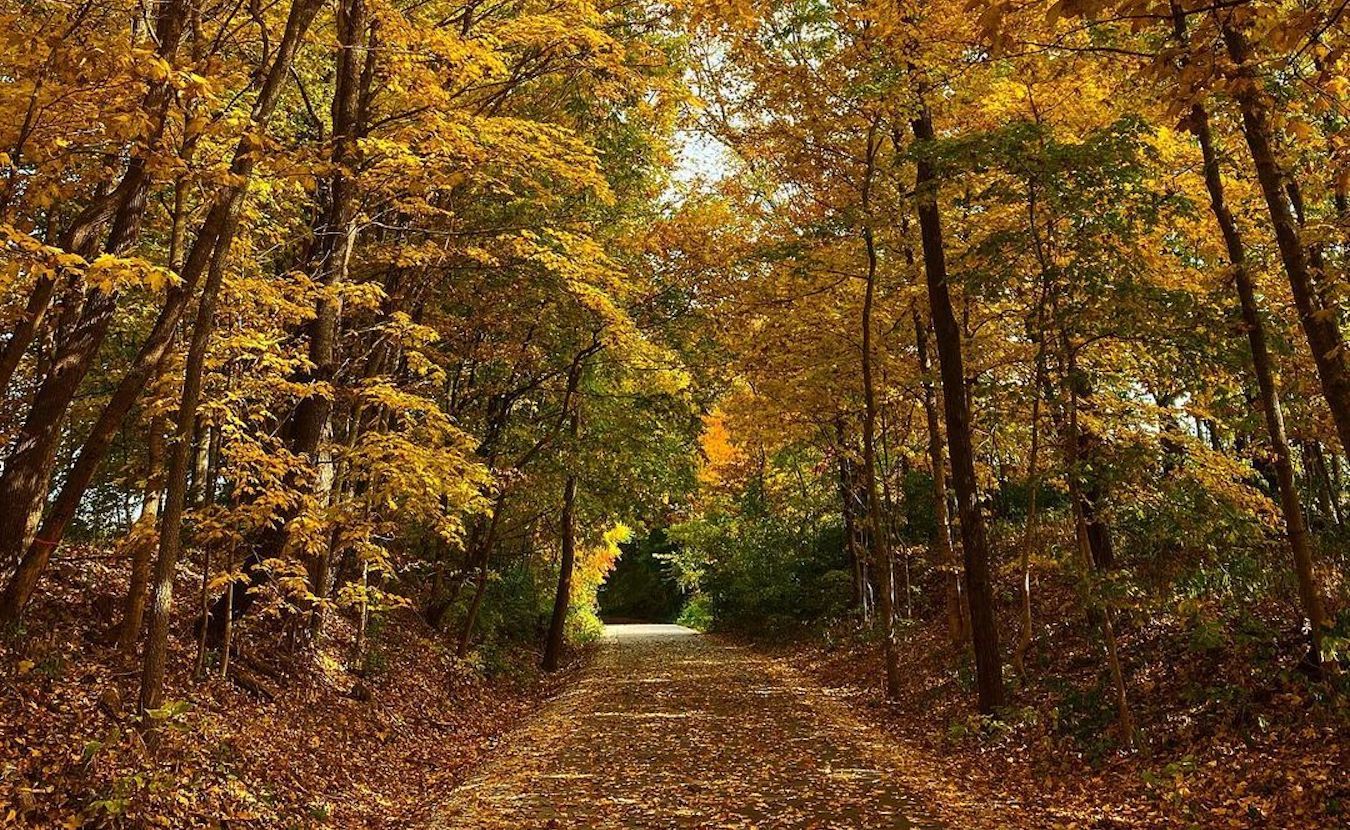Trees and their role in climate resilience

This 34-inch-diameter pin oak by the Bryan Park tennis courts could potentially absorb enough stormwater to fill 743,950 16.9 oz. plastic bottles and pull one car’s worth of CO₂ from the atmosphere. | Photo by Eric Fritz
In an era when climate change is reshaping our world, urban forests play a vital role in boosting resilience within cities, including in Bloomington.
Beyond their aesthetic charm, street trees, woodlots, trees in parks, and trees surrounding your home act as buffers against the escalating impacts of climate change, such as intensified periods of drought and heat stress and increased flooding events. Trees act as nature’s carbon sinks, absorbing greenhouse gasses and mitigating air pollution, alleviating urban heat-island effects. They provide essential shade, lowering ambient temperatures and curbing energy consumption during the scorching summers we’ve been experiencing in the Midwest. Urban forests also serve as effective stormwater management systems, absorbing and slowing rainwater and lessening the risk of flooding and erosion.
As a testament to their vast benefits, we can explore Bloomington’s TreeKeeper platform, a live inventory of every publicly owned tree in the city. Consider the 34-inch-diameter pin oak that shades the Bryan Park tennis courts — according to the iTree modeling system, “With care and maintenance, after 20 years, this tree could potentially remove pollution from the air we breathe equivalent in weight to that of 297 8-inch bananas, absorb enough stormwater to fill 743,950 16.9 oz. plastic bottles, and pull one car’s worth of CO₂ from the atmosphere.”
With this in mind, imagine the quantifiable impact that all of the trees in our city have put together!
The Inflation Reduction Act’s dedicated funding for urban forestry efforts arrives as a timely and crucial stride towards defending and embracing these natural green assets in our cities and towns. This novel legislation acknowledges the multifaceted benefits of greenspaces and trees in building climate resilience, promoting public health, and improving community well-being.
Funding efforts like this one are important because urban trees “need proper care and maintenance to thrive,” according to Bluestone Tree, a local tree-service company. Such care requires a level of commitment from all residents of a community, including tree service companies, “working with homeowners and businesses that recognize the importance of proper tree health and maintenance.” (Read more about Bluestone Tree here and at the end of this article.)
Trees are just one type of sustainable solution to an uncertain future, but it’s undeniable that they give our communities life, boost the sustainability of our urban spaces, and should be enjoyed for generations to come. It could, and should, be argued that they are worthy of being at the forefront of our quest for a greener future.
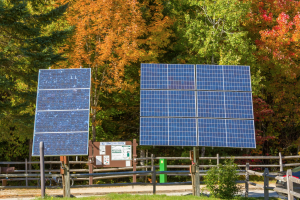
Planting trees or installing solar panels does not have to be a binary choice. Rooftop solar installations, solar carports, and creative architectural designs allow us to harness renewable energy without sacrificing trees. Deliberate urban planning can cultivate a balance between sustainable solutions.
Trees, solar panels, and urbanization
The pursuit of sustainable solutions has unfolded a critical conversation: the conflict between solar panels and trees, with the added challenge of rapid urban sprawl in Bloomington. While solar panels undoubtedly offer a greener energy alternative to existing and new infrastructure, we should carefully consider the invaluable role that trees have, and we should advocate for their preservation and prioritization as we shape our fast-expanding urban landscape. Trees are deeply rooted in our city’s identity, but they seem to have become an afterthought in recent development and planning projects. This is exemplified by mass removals leaving a clean slate for new-builds, or rows of balled and burlapped trees waiting to be planted in the ground post-construction, only to succumb to the impacts of drought.
The choice at hand doesn’t have to be a binary one, however. Through deliberate urban planning, we can cultivate a balance between these sustainable solutions. Rooftop solar installations, solar carports, and creative architectural designs allow us to harness renewable energy without sacrificing trees. It’s possible that thoughtful pruning of trees may be enough for them to coexist with solar panel deployment.
Incorporating credentialed arborists and urban forest professionals in the initial planning process of projects should be a standard procedure — to help protect against unnecessary loss of trees and ensure that new trees have a maintenance plan in place. This balanced approach underscores our commitment as a community to sustainability and echoes our admiration for the natural assets of Bloomington.
Caring for what we have
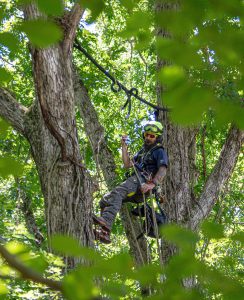
Managing mature trees is just as important as planting new trees in sustaining our urban canopy for future generations. Above, an ISA Certified Arborist from Bluestone Tree descends a tree after installing a flexible bracing system in a double trunk tree.
Planting new trees will be an essential step in sustaining our urban canopy for future generations, but managing mature trees is just as important. However, there are instances when a tree’s seemingly unsafe condition raises concerns about its potential risks. An immediate reaction might be to swiftly remove the tree, but it’s imperative to remember that trees are complex living things, and just because a tree seems hazardous to the untrained eye doesn’t always mean that it is. Professional arborists, trained and experienced in tree health assessment, are the ideal partners in these situations.
Engaging a certified arborist before deciding to remove a tree not only safeguards our natural and built environment but also empowers us to make informed decisions that align with both safety and sustainability. Arborists consider factors such as the tree’s species, its potential benefits to the ecosystem, and any health issues and potential risk the tree may have. With an arborist’s informed, expert guidance, we can explore options like pruning, cabling, or other treatments that might extend the tree’s life while mitigating risks.
Our responsibility as stewards of our environment goes beyond just maintenance; it involves a thoughtful balance between safety and preservation. So, the next time an apparently unsafe tree raises concerns, we should pause before reaching for a chainsaw, and we should consult a credentialed arborist. After all, a tree’s fate is not solely defined by its present condition but also by the expertise that guides its future. Bloomington is lucky to have a wealth of knowledge about trees shared across passionate community members, environmental organizations, and tree care professionals.
Considerations for tree owners and stewards
Urban trees require human intervention to thrive, which calls upon the recognition of our collective role in managing them for future need and enjoyment. Community involvement has the potential to be a pillar of successful and sustainable urban forest management in Bloomington, where you and your neighbors can:
- Organize tree planting events and tree walks with the help of local organizations such as CanopyBloomington.
- Come together to steward and learn about your local green infrastructure.
- Care for the existing trees at your home or in your neighborhood by mulching them throughout the year and watering them in times of drought.
- Engage local arborists for advice and assistance in choosing the right trees for the right places and making informed decisions before having trees removed.
Knowledge sharing and pooling resources can make a substantial impact. Awareness, often the spark for engagement, is equally important. Learn about the trees that inhabit your surroundings, their characteristics, and their unique contributions to the urban ecosystem.
The path to reaping and sustaining the benefits of our urban forest demands intentional urban planning and community involvement. We must proactively designate green spaces, protect existing trees and woodland pockets, and plant new trees with diversity in mind. The participation of residents, businesses, nonprofit organizations, schools and other players in Bloomington is crucial in sustainable management efforts and fostering relationships to cooperatively steward our urban forest.
In the face of a changing climate, trees are not a luxury but a necessity. As urbanization accelerates and climate threats escalate, investing in the lungs of our urban spaces is an investment in the very sustainability and livability of our future Bloomington.
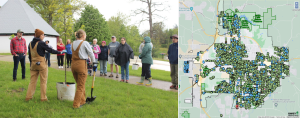
(left) A community tree planting and education demonstration by CanopyBloomington. | Photo by Caroline Woertz; (right) Screenshot of Bloomington TreeKeeper page shows a live inventory of every publicly owned tree in the city.
About Bluestone Tree
3090 S. Walnut St. Bloomington, IN 47401
Phone: 812-824-3335
Email: [email protected]
Click below for more:
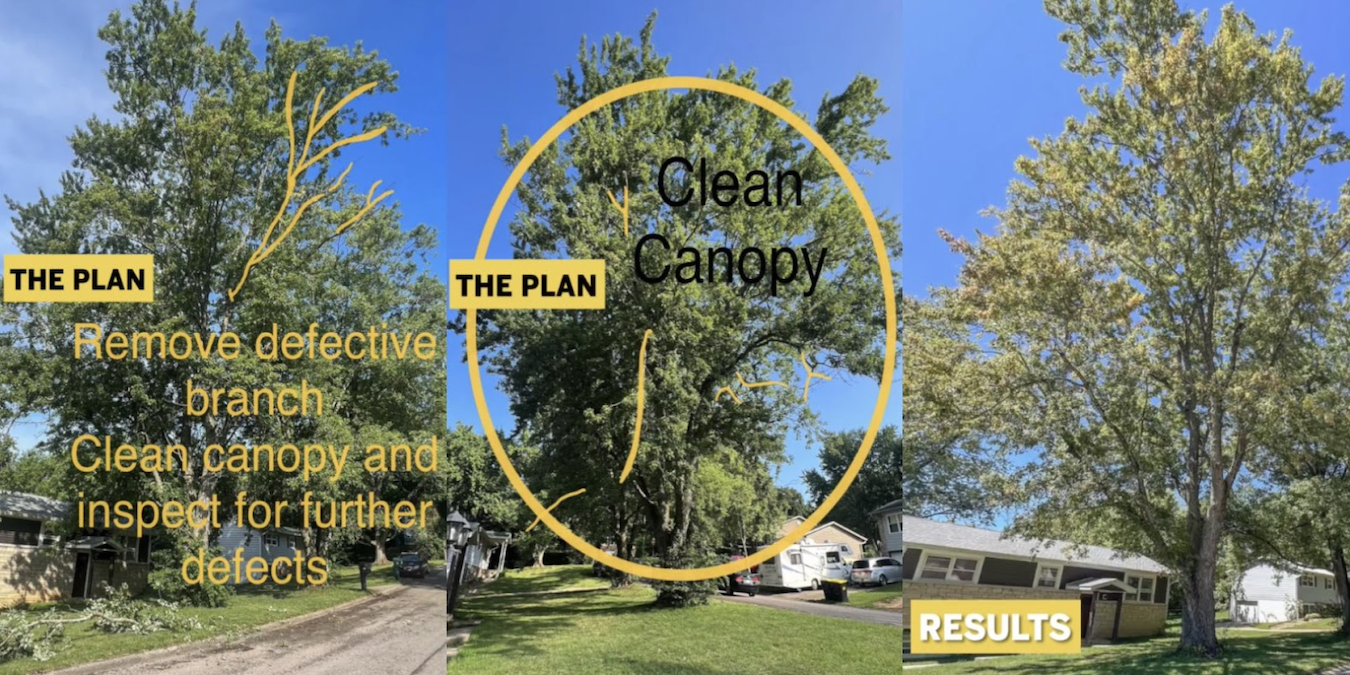
Click the image above or here to watch a video of a mature silver maple tree being pruned. | Video by Bluestone Tree

